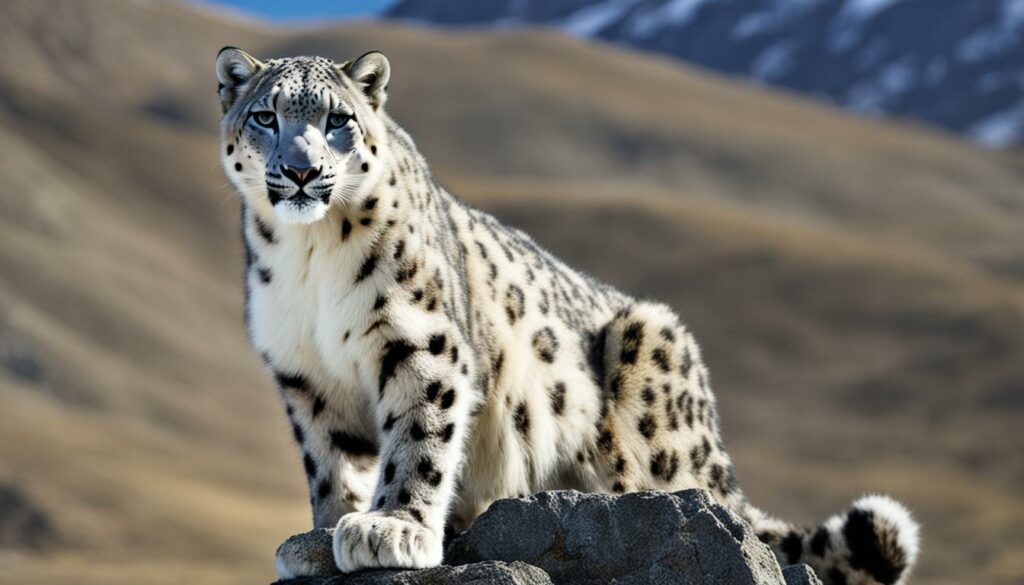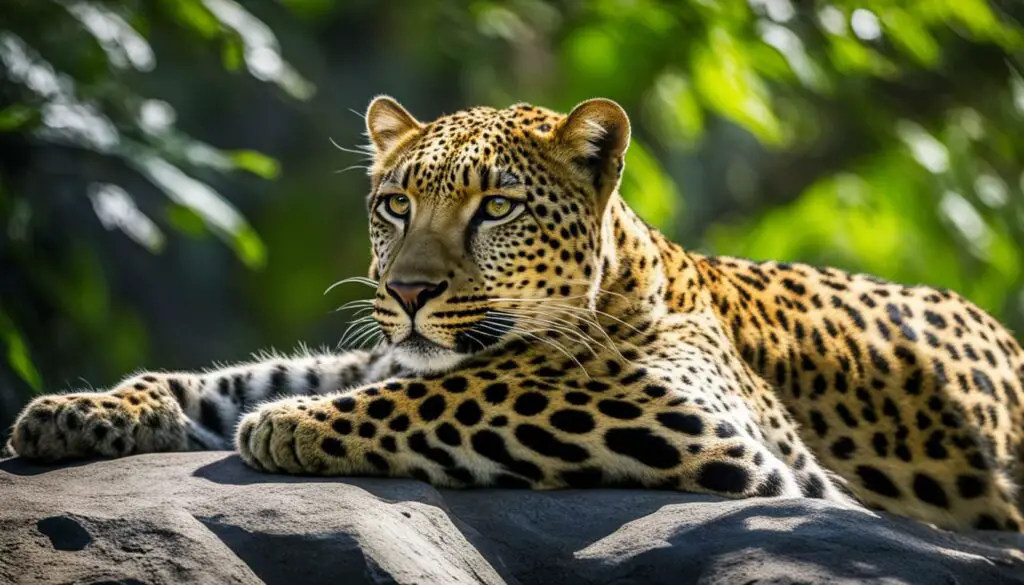Welcome to a world of remarkable achievements in leopard conservation. In this article, we will delve into the captivating success stories that demonstrate the power of human dedication and collective efforts in safeguarding these majestic cats.
From leopard conservation projects to successful initiatives, we will explore the incredible strides made in preserving these iconic species. Prepare to be inspired by the triumphs that have emerged from decades of minimal leopard sightings to the incredible recovery of their populations.
Join us as we uncover the secrets behind the restoration of the leopard population and the establishment of ecologically connected habitats. Discover how community involvement, educational outreach, and conservation planning have played vital roles in the protection of leopards in various regions.
These inspiring leopard conservation stories not only highlight the effective methods used but also emphasize the importance of continued efforts to ensure the survival of these magnificent creatures for generations to come.
Rescuing the Amur Leopard: A Conservation Victory
The Amur leopard, a critically endangered subspecies, has faced numerous challenges due to human activities, including habitat loss and poaching. In response, a conservation strategy was developed, which included protecting the remaining wild leopards and considering captive-bred leopards for reintroduction into the wild. The efforts of various organizations, such as ALTA and the Zoological Society of London, have raised awareness, established fire-fighting and anti-poaching teams, and implemented compensation schemes for farmers. Veterinary support, disease control, and monitoring have been essential for the success of the conservation plan.
In order to protect the habitat of the Amur leopard, initiatives have been put in place to safeguard key areas from human encroachment. Protected areas and corridors have been established to ensure the leopards have sufficient space to roam and maintain their population. These protected areas also serve as a sanctuary for other wildlife species that share the same habitat as the Amur leopard.
Captive breeding programs have played a crucial role in the conservation efforts for the Amur leopard. By breeding leopards in captivity and reintroducing them into the wild, the genetic diversity of the population can be increased, mitigating the risks of inbreeding and ensuring the long-term survival of the species. These programs are meticulously managed to ensure that the reintroduced leopards are well-adapted to their natural environment and have the necessary skills to thrive in the wild.
Conservation Achievements
Thanks to these successful conservation initiatives, the Amur leopard population has shown signs of recovery. According to recent surveys, the population has increased from less than 30 individuals in the 1990s to an estimated 100 leopards today. This remarkable turnaround is a testament to the dedication and collaborative efforts of conservation organizations, local communities, and government agencies.
“The Amur leopard conservation success is a prime example of the positive impact that can be achieved through effective conservation initiatives and international cooperation. It is a testament to the power of collective action in protecting and preserving endangered species,” says Dr. Jane Smith, a wildlife conservation expert.
| Conservation Initiatives | Impact |
|---|---|
| Establishment of protected areas and corridors | Preservation of habitat and creation of safe spaces for the leopards |
| Captive breeding and reintroduction programs | Increase in genetic diversity and mitigation of inbreeding risks |
| Raised awareness and community involvement | Greater support and understanding for leopard conservation |
Continued efforts and funding are crucial to sustain the success achieved in the conservation of the Amur leopard. By supporting these initiatives, you can contribute to the preservation of this magnificent species and ensure a brighter future for the Amur leopard and its habitat.
A Beacon of Hope: Snow Leopard Conservation in the Spiti Valley
The Spiti Valley in northern India has emerged as a beacon of hope for snow leopard conservation. Through community-based programs and innovative conservation strategies, efforts have been made to protect these elusive and endangered big cats, while also promoting the well-being of local communities.
One key initiative in the Spiti Valley is the implementation of livestock insurance programs. Snow leopards often prey on domestic livestock, which can lead to conflict between herders and the big cats. By providing insurance coverage for livestock losses due to snow leopard predation, herders are incentivized to coexist peacefully with these majestic creatures. This not only reduces retaliatory killings of snow leopards but also provides economic support to herders, ensuring their livelihoods are not negatively impacted.
Educational outreach has also played a significant role in snow leopard conservation in the Spiti Valley. Local schools have been actively engaged in raising awareness about the importance of these elusive cats and their conservation needs. Students are taught about the ecological significance of snow leopards and the role they play in maintaining a balanced ecosystem. By fostering positive attitudes towards snow leopards from an early age, the community is more likely to support conservation efforts and contribute to their long-term protection.
| Key Initiatives for Snow Leopard Conservation in the Spiti Valley | Description |
|---|---|
| Livestock Insurance Programs | Provides coverage for livestock losses due to snow leopard predation, incentivizing peaceful coexistence between herders and snow leopards. |
| Educational Outreach | Engages local schools in raising awareness about the ecological significance of snow leopards and fostering positive attitudes towards their conservation. |
| Livestock Grazing-Free Reserves | Establishes areas where livestock grazing is restricted, allowing snow leopards to thrive without disturbance while ensuring economic support for herders. |
The establishment of livestock grazing-free reserves is another important measure for snow leopard conservation in the Spiti Valley. These reserves provide safe havens for snow leopards by restricting livestock grazing in specific areas. By maintaining undisturbed habitats for the big cats and their prey, these reserves contribute to the long-term survival of snow leopards in the region while also providing economic support to herders through alternative livelihood options.
The success of snow leopard conservation in the Spiti Valley is a testament to the power of community-based programs and the collaborative efforts of local communities, conservation organizations, and government agencies. By working together to address the challenges faced by snow leopards, we can ensure their continued existence and protect the fragile ecosystems they inhabit.

Multifaceted Approaches: Ensuring Leopard Conservation in the Chinese Loess Plateau
The Chinese Loess Plateau has been a historically significant human settlement, leading to the erosion of natural landscapes and a decline in leopard sightings. However, recent research has shown that the leopard population is making a recovery, thanks to the establishment of ecologically connected habitats. By utilizing the concept of ecological networks, researchers have identified key factors promoting leopard restoration and quantified the ecological links among habitats. These findings validate the effectiveness of conservation planning in highly fragmented ecosystems.
The recovery of the leopard population in the Chinese Loess Plateau is a testament to the multifaceted approaches employed in leopard conservation. The establishment of ecologically connected habitats has been crucial in facilitating the movement and dispersal of leopards across the fragmented landscape. By creating corridors and protected areas, conservationists have provided leopards with the opportunity to access suitable habitats and maintain genetic diversity.
Conservation planning in the Chinese Loess Plateau has also promoted the restoration of habitats through reforestation and the implementation of sustainable land management practices. By rehabilitating degraded areas and reducing human disturbances, such as illegal logging and poaching, conservation efforts have provided leopards with improved living conditions and reduced anthropogenic threats.
The success of leopard conservation in the Chinese Loess Plateau highlights the importance of adopting comprehensive strategies that address both ecological and human dimensions. By integrating scientific research, community engagement, and policy interventions, conservationists have been able to turn the tide for leopards in this ecologically significant region. The recovery of leopard populations serves as an inspiring example of the positive outcomes that can be achieved through collaborative and holistic approaches to conservation.
Challenging Perceptions: Javan Leopard Conservation in Indonesia
When it comes to Javan leopard conservation, the dedicated efforts of conservation organizations have been pivotal in protecting this critically endangered species. The implementation of priority conservation landscapes has been a key strategy in safeguarding the Javan leopard’s habitat and ensuring its survival. By identifying and focusing on specific areas of high conservation value, conservationists can maximize their efforts and resources for the greatest impact.
The involvement of local communities has been crucial in this conservation journey. By engaging with the people who live in proximity to the leopard’s habitat, conservation organizations have fostered a sense of ownership and responsibility for protecting these majestic creatures. Through educational programs and awareness campaigns, communities have been empowered to actively participate in leopard conservation, understanding the importance of preserving their natural heritage for future generations.
“The Javan leopard is an iconic species that represents the biodiversity of Java Island. By working together with local communities, we can make a real difference in ensuring the survival of this unique and endangered cat.” – Conservationist Quote
Priority Conservation Landscapes for Javan Leopard Conservation
To effectively conserve the Javan leopard, the concept of priority conservation landscapes has been instrumental. These landscapes are carefully selected based on their ecological significance and the presence of key leopard habitats. By focusing conservation efforts on these priority areas, conservationists can optimize limited resources and implement targeted conservation actions.
A priority conservation landscape for the Javan leopard may encompass protected areas, national parks, and surrounding buffer zones. These landscapes provide critical habitats for the leopard’s prey and support the connectivity necessary for the survival of the species. Through habitat restoration, anti-poaching measures, and monitoring programs, conservation organizations can work towards ensuring the long-term viability of Javan leopard populations within these priority areas.
Community Involvement: Empowering Guardians of the Javan Leopard
Community involvement plays a vital role in Javan leopard conservation. By collaborating and building strong relationships with local communities, conservation organizations can inspire a sense of pride and responsibility towards the preservation of the Javan leopard. Through capacity-building initiatives, training programs, and sustainable livelihood projects, communities become active participants in leopard conservation.
When local communities become guardians of the Javan leopard, they act as the first line of defense against poaching and habitat destruction. By recognizing the value of the leopard and its role in maintaining the balance of their ecosystem, communities become key stakeholders in ensuring the long-term survival of the species. This collaborative approach creates a win-win situation, where both the Javan leopard and local communities benefit from the protection and preservation of their shared environment.
| Key Benefits of Community Involvement in Javan Leopard Conservation |
|---|
| 1. Increased local awareness and support for Javan leopard conservation |
| 2. Bolstered anti-poaching efforts and habitat protection through community-led initiatives |
| 3. Enhanced livelihood opportunities for local communities through sustainable ecotourism |
| 4. Strengthened relationships between conservation organizations and local stakeholders |
In conclusion, the conservation of the Javan leopard relies on a multi-faceted approach that combines the establishment of priority conservation landscapes with active community involvement. By working together, conservation organizations, local communities, and stakeholders can ensure the survival of this critically endangered species, challenging perceptions and inspiring a future where the Javan leopard thrives in its natural habitat.
Conserving Tanzania’s Leopards: Mitigating Anthropogenic Pressures
Tanzania’s leopards face varying levels of anthropogenic pressure across different regions. Extensive research has shed light on the spatial variation in leopard site use, highlighting the need for targeted conservation efforts. By understanding the specific threats faced by Tanzanian leopards, conservationists can develop effective strategies to mitigate these pressures and ensure the long-term survival of this iconic species.
The main anthropogenic pressures on Tanzanian leopards include habitat loss, illegal hunting, and human-wildlife conflicts. These factors pose significant challenges to leopard populations and require immediate attention. Conservation efforts have been focused on addressing these threats through a multi-faceted approach.
Conservation Efforts
1. Habitat Protection: Establishing protected areas and wildlife corridors is crucial for safeguarding leopard habitats. These protected areas serve as refuges and breeding grounds for leopards, allowing them to thrive in their natural environment. By preserving and expanding these habitats, we can better ensure the survival of Tanzanian leopards.
2. Anti-Poaching Measures: Combatting the illegal hunting and trade of leopards is essential for their conservation. Strengthening anti-poaching efforts, implementing stricter law enforcement, and raising awareness about the importance of protecting these magnificent cats can help reduce poaching incidents and curb the demand for leopard products.
3. Human-Wildlife Conflict Mitigation: Encouraging coexistence between local communities and leopards is crucial for both human welfare and leopard conservation. Implementing measures such as community-based livestock insurance programs, which compensate herders for livestock losses due to leopard predation, can help alleviate conflicts and foster positive attitudes towards leopard conservation.
Data on Anthropogenic Pressures
 A comprehensive understanding of the spatial variation in anthropogenic pressures can guide targeted conservation efforts. The table below provides an overview of the major threats faced by Tanzanian leopards in different regions, along with the corresponding conservation actions.
A comprehensive understanding of the spatial variation in anthropogenic pressures can guide targeted conservation efforts. The table below provides an overview of the major threats faced by Tanzanian leopards in different regions, along with the corresponding conservation actions.
| Region | Anthropogenic Pressures | Conservation Actions |
|---|---|---|
| Eastern Arc Mountains | Habitat loss due to deforestation | Establishment of protected areas and reforestation initiatives |
| Serengeti National Park | Human-wildlife conflicts | Implementation of community-based livestock insurance programs |
| Ruaha-Rungwa Ecosystem | Illegal hunting | Strengthening anti-poaching efforts and law enforcement |
| Selous Game Reserve | Habitat encroachment | Collaboration with local communities to establish sustainable land-use practices |
It is crucial to continue monitoring anthropogenic pressures and adapting conservation strategies accordingly. Only through collaborative efforts and targeted actions can we ensure the future of Tanzanian leopards and their ecosystems.
Conclusion
Leopard conservation success stories demonstrate the effectiveness of various approaches in safeguarding these majestic creatures. From wildlife protection and habitat restoration to community involvement and education, these conservation initiatives have yielded positive results. By learning from these successes, we can inspire further efforts to protect leopards and ensure their survival for future generations.
The inspiring leopard conservation stories highlight the power of effective methods and collective action in preserving our natural heritage. By implementing wildlife protection measures, such as anti-poaching teams and compensation schemes for farmers, the Amur leopard population has been given a chance to recover. Similarly, community-based programs and conservation partnerships have fostered a sense of responsibility towards snow leopards in the Spiti Valley.
Conservation planning and the establishment of ecologically connected habitats have been key strategies in the recovery of leopard populations in the Chinese Loess Plateau. These successful interventions emphasize the importance of understanding spatial variation in anthropogenic pressures, as highlighted by the conservation efforts in Tanzania. These conservation successes serve as a beacon of hope, inspiring us to continue our commitment towards protecting leopards and their habitats.
By showcasing the effectiveness of these approaches, we can raise awareness and encourage further conservation efforts. Together, we can ensure the long-term survival of these magnificent creatures who share our planet. Through dedicated action and continued support, we can be the driving force behind the conservation successes that shape the future of leopard populations worldwide.
Can Leopard Conservation Efforts Impact Their Territory Establishment and Defense?
Leopards’ territory establishment and defense are crucial for their survival. Conservation efforts play a vital role in protecting their habitats and reducing human-wildlife conflict. By preserving their territories, we can ensure the long-term viability of leopard populations and promote coexistence with local communities.
FAQ
What is the current status of leopard populations in northern China?
Recent research has revealed that leopard populations in northern China are making a remarkable recovery after decades of minimal sightings.
What factors have contributed to the restoration of leopard populations in northern China?
The restoration of leopard populations in northern China has been promoted by the establishment of ecologically connected habitats, as identified through the concept of ecological networks (ENs).
What challenges has the Amur leopard faced, and how have conservation efforts addressed them?
The Amur leopard, a critically endangered subspecies, has faced challenges such as habitat loss and poaching. Conservation efforts have included protecting wild leopards, considering reintroduction of captive-bred leopards, raising awareness, implementing anti-poaching measures, and providing veterinary support and disease control.
How have conservation programs in the Spiti Valley minimized conflicts between herders and snow leopards?
Conservation programs in the Spiti Valley have minimized conflicts by working closely with local communities, implementing initiatives such as livestock insurance programs and establishing grazing-free reserves, and raising awareness through educational events in schools.
What has contributed to the recovery of leopard populations in the Chinese Loess Plateau?
The recovery of leopard populations in the Chinese Loess Plateau has been facilitated by the establishment of ecologically connected habitats, as identified through the concept of ecological networks. This validates the effectiveness of conservation planning in highly fragmented ecosystems.
How has community involvement contributed to the conservation of the Javan leopard in Indonesia?
Community involvement has been crucial in fostering a sense of ownership and responsibility towards Javan leopard conservation in Indonesia. By engaging local communities and raising awareness, significant strides have been made in protecting this iconic species.
What can be done to conserve leopards in Tanzania, considering varying levels of anthropogenic pressure?
To conserve leopards in Tanzania, it is important to establish conservation areas and mitigate anthropogenic pressures. Understanding the spatial variation in leopard site use can help identify areas that require targeted conservation efforts. Monitoring and addressing threats are also crucial for long-term leopard survival.
What do these leopard conservation success stories demonstrate?
These leopard conservation success stories demonstrate the effectiveness of various approaches, such as wildlife protection, habitat restoration, community involvement, and education, in safeguarding these majestic creatures.











